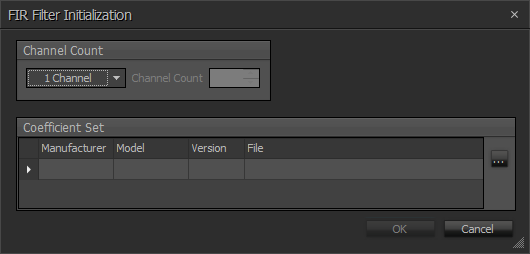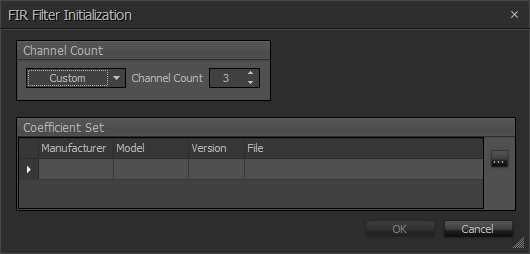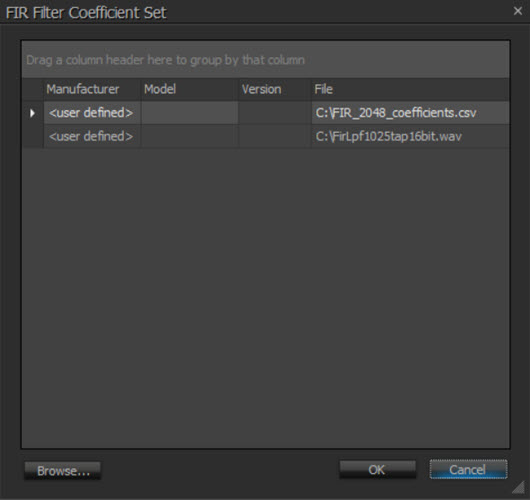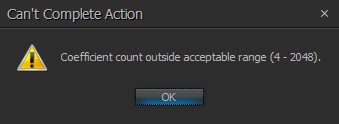FIR Filter
The FIR Filter object provides a way of importing a set of FIR filter coefficients and filtering an audio signal through those coefficients. The linear phase nature of the FIR Filter makes it useful for static filter applications such as inverse loudspeaker curves, crossovers, line array steering and the like. When the FIR Filter block is created from the Object Toolbar, an initialization dialog is presented which allows the user to browse to and select a coefficient file. The file can be in 16 or 24-bit, 48kHz, mono or stereo WAVE (.wav) format or ASCII text in comma separated variable (.csv) format, and can contain a minimum of 4 and a maximum of 2048 coefficients. Coefficients should be between -1.0 and +1.0. Filter coefficients should be synthesized assuming a 48kHz sampling rate.
Initialization Dialog


| Name | Description |
| Channel Count | Select from a list of default channel counts or set a custom amount (up to 32). |
Note: Once a Coefficient file has been selected, the maximum number of channels available will be limited to ensure the block can fit on any Server-Class device.
Prior to placing the FIR filter DSP block, the user must browse to and select a coefficient file. The OK button is disabled until a valid file is selected. Click the  button to navigate to coefficient filter sets. The list will be empty when first accessing the Fir Filter Coefficient Sets:
button to navigate to coefficient filter sets. The list will be empty when first accessing the Fir Filter Coefficient Sets:

Click Browse and navigate to a coefficient file location. After the file is selected and the file chooser closed, the file will be validated to confirm it is a FIR filter coefficient set and it will be added to the grid. Invalid files will not be added to the selection grid.
Select a set from the grid and click okay. The selection grid will close and the FIR filter initialization will show the selected coefficient set.

Note that the FIR Filter Coefficient Set dialog will retain/show the selected coefficients during the same software session.
DSP Block Representation

The FIR Filter block is fixed at one input and one output.
Control Dialog

The only control for the FIR filter is a Bypass button, which bypasses the filter.
Warning and Errors
Numerous error and warning dialogs may appear if certain parameters are not met during FIR set up and initialization.
If the FIR filter coefficient file selected during initialization has a coefficient count that falls outside of the acceptable range, the following error dialog will display:

Scaled values should be between -1 and 1. If coefficient values have been improperly scaled, the following error dialog will display:

Each FIR filter has an associated sample rate that must match the sample rate of the partition in which the filter is placed. If a filter is placed in a partition that has a different sample rate than that of the filter, the following error dialog will display:

This parameter will only apply to .wav files as they have a sample rate imbedded within that is assigned to the FIR filter. This will not apply to .csv files, as they are automatically assigned the sample rate of the partition in which the FIR filter is being placed.
If changes to the sample rate are made to an initialized FIR filter the filter would be invalidated and all associated coefficients deleted. A warning dialog will notify the user of the pending action:

Transfer Function
The transfer function may be used to graph the FIR filter. See the Transfer Function section for more information on using this feature, but an example configuration using the transfer function with a FIR filter is shown below:
